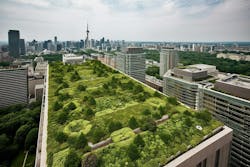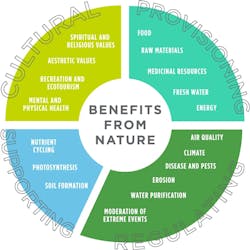4 considerations for increasing biodiversity in construction projects
When we spend time in nature, we instinctively feel its value. To quantify that value, the concept of “natural capital” has been developed so that organizations can measure its impact and thus make more informed decisions. Natural capital measures the services that ecosystems provide. These could be, for example, acting as a carbon sink, food production, erosion prevention, air quality improvement, or providing mental health benefits to people spending time in the area.
There’s more focus than ever on the environmental impact of construction projects. As well as following environmental regulations, developers must navigate their own companies’ sustainability policies, as well as those of their clients and supply chain partners. There is also, rightly, growing public scrutiny of projects, requiring developers to measure the environmental impact of their work and communicate it to stakeholders effectively.
Now a greater emphasis is placed on the importance of safeguarding and promoting biodiversity throughout construction projects. The U.K. government is in the process of implementing a requirement for certain construction projects to deliver a biodiversity net gain of at least 10%, as well as creating or enhancing habitat to be maintained for at least 30 years. These new regulations will not only deliver environmental improvements in future projects, but also help to increase the momentum of biodiversity net gain within construction. Determining whether a net gain has been delivered will depend on using appropriate tools and metrics to quantify the effect, such as the Biodiversity Metric.
The increased focus—and strengthened legal requirements—on biodiversity will have significant reverberations. As climate change is clearly linked with biodiversity depletion, fostering biodiverse landscapes during construction can create benefits beyond the immediate surroundings of the project. For developers who will soon be required to map out how they will deliver biodiversity net gain through their projects, there are four clear areas to consider.
1. Biodiversity in Design
There is a wide range of changes that engineers and architects can make to their designs to promote biodiversity. The first consideration is how to minimize the impact on the local environment by using sympathetic materials and reducing the geographical footprint of the site. This allows more space for habitat creation through appropriate landscaping.
There are other human-made options for creating areas conducive to flourishing animal and plant life. This includes creating hibernaculum: underground chambers that animals can use throughout winter to protect themselves from the cold. Bat boxes and bee embankments are also relatively easy methods to create wildlife-friendly habitats.
Alongside the project site, planting wildflower meadows in unused areas outside the main build can create lively feeding and nesting grounds for insects, birds, and small animals. Choosing flora that is consistent with the local area helps support a healthy wildlife population. When introducing new flora and fauna to an area, consultation with local conservation groups is beneficial for understanding and implementing cohesive interventions.
2. Biodiversity During the Build Process
It’s easy to assume that the biodiversity legacy of a project will be determined by the final build. The result is undeniably important, but the design will not be as effective as it could be if biodiversity is not considered until the end. The most effective way to boost biodiversity in a construction project is to take a holistic approach, addressing possibilities at every stage, including the build process.
For example, access roads are created in large project sites for vehicles and machinery. These potentially disrupt local animal and plant life. While some disruption is inevitable, the routes of access roads should be planned to minimize their impact and maintain green corridors. Where possible, using soil stabilization or reinforced grass to enable access to a site can help safeguard biodiversity further still.
3. Biodiversity in Every Project
Project sites with green space, usually in rural locations, are naturally the first to spring to mind when we plan biodiversity promotion. In reality, there are both opportunities and challenges in promoting biodiversity regardless of the site’s land type. On urban sites, where existing biodiversity may be limited, the construction project may offer the opportunity to introduce a new habitat or nature area, providing it is compatible with the local community. Even urban sites with limited space can help rebuild wildlife corridors, especially for pollinators. Sometimes initiatives can seem to be minimal, but even small-scale planting can help reintroduce species into an area.
Urban-based projects with a high level of footfall in the surrounding area also present opportunities to add social value. The safety hoardings surrounding a project site—often left blank or adorned with company marketing—are a great place to include information on safeguarding biodiversity, as well as other educational messages.
4. Taking a Natural Capital Approach
Natural capital consists of the elements of the natural environment that provide valuable goods and services to people. Taking the broader natural capital impact into account when carrying out an infrastructure project can deliver both climate and biodiversity benefits. While these issues are closely linked, it is important to measure and understand the impact each project is having on these distinct environmental challenges. By considering natural capital, infrastructure projects can play a part in tackling climate and biodiversity challenges.
As environmental requirements accelerate for construction projects, program management information systems can help construction managers streamline information access.

